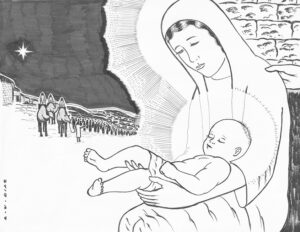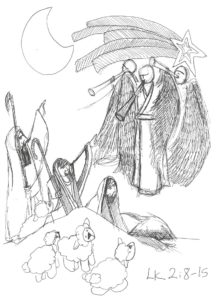“Today in the city of David a savior has been born for you who is Messiah and Lord.”
Christmas at Casa Juan Diego is like Christmas all over the world. Given the many countries that our guests call home, you could say that the world gathers at Casa Juan Diego for Christmas. The festivities begin on Christmas Eve with the sacred celebration which Christians have been practicing for two thousand years. After Mass, the men and women return to their respective homes and receive gifts. Eventually, everyone makes their way to bed and the celebrations continue the next day.
Christmas at Casa Juan Diego is no different than Christmas elsewhere in the world. Simultaneously, I believe there is nothing quite like it.
I first came to Casa Juan Diego in 2019 as a recent graduate eager to be a full-time Catholic Worker. I had heard Dorothy Day’s wish that each house of hospitality would be a sort of school for young people, and I wanted to make myself a student of this kind of love in action. To my surprise, the more I learned about Catholic Worker thought as developed by Peter Maurin and Dorothy, the more I could feel echoes within me of the other great teacher in my life: Maria Montessori, the Italian doctor who developed a revolutionary, child-centered approach to education in the early 1900s. I grew up a Montessori child in a Catholic family, and the worldview I inherited in that setting fit naturally with Catholic Worker ideas of personalism and freedom. After my time living at Casa Juan Diego, I temporarily left Houston to be trained as a Montessori elementary teacher. I now teach 9-12 year-olds and continue to learn at the school of love which is the Houston Catholic Worker.
One of the most obvious ways that a house of hospitality acts as a school is through the regular “clarification of thought”. At Casa Juan Diego, this time for reading and discussion has recently focused on Mark and Louise Zwick’s The Catholic Worker Movement: Intellectual and Spiritual Origins. One Wednesday, the discussion turned to Nicholas Berdyaev and his influence on the thought of Peter Maurin. Berdyaev (1847 – 1948) was a Russian philosopher and theologian whose attention to Christian freedom was hugely impactful in Peter’s writing and Catholic Worker thought.
Together with Berdyaev, Peter Maurin was critical of historical frameworks that denied the centrality of Christ’s life in the unfolding of human history. In Berdyaev’s words, “There is no such thing as historical progress. The present is in no ways an improvement on the past. A period of high cultural development is succeeded by another wherein culture deteriorates qualitatively.” (Qtd. in Zwick) If we are not to read history as an ever-changing promise of future perfection, then we need some other reference point in order to make sense of it all. The Catholic Worker has taught me that in order for the story of humankind to be seen clearly, the central point needs to be Christ’s life.
This message – of the importance of Christ in our historical landscape, of the necessity to make Christ the center of our history – is one that keeps popping up in my life. It is becoming impossible for me to ignore.
Perhaps it’s fitting that the only way I can think about Christ in history or Christ in my life is through stories. For one thing, the Catholic Worker is a movement that has collected stories since its beginning. To read Dorothy Day is to settle into a steady stream of stories. Her books and articles are peppered with accounts of the people she lived with, encountered, and loved. For another, storytelling is so deeply human and so very old that it was thriving long before God became man. In Peter Maurin’s view, it’s that story that we need to hold firmly in the center of all the others.
In those days a decree went out from Caesar Augustus that the whole world should be enrolled. This was the first enrollment, when Quirinius was governor of Syria. So all went to be enrolled, each to his own town. And Joseph too went up from Galilee from the town of Nazareth to Judea, to the city of David that is called Bethlehem, because he was of the house and family of David, to be enrolled with Mary, his betrothed, who was with child.
While they were there, the time came for her to have her child, and she gave birth to her firstborn son. She wrapped him in swaddling clothes and laid him in a manger, because there was no room for them in the inn. Now there were shepherds in that region living in the fields and keeping the night watch over their flock. The angel of the Lord appeared to them and the glory of the Lord shone around them, and they were struck with great fear. The angel said to them, “Do not be afraid; for behold, I proclaim to you good news of great joy that will be for all the people. For today in the city of David a savior has been born for you who is Messiah and Lord. And this will be a sign for you: you will find an infant wrapped in swaddling clothes and lying in a manger.”
And suddenly there was a multitude of the heavenly host with the angel, praising God and saying: “Glory to God in the highest and on earth peace to those on whom his favor rests.” (Lk 2:1-14)
In Montessori at the elementary level, storytelling is extremely important as well. It’s through stories that we strike the imagination of the child and communicate things that are deeply true. Out of all the stories I learned in my Montessori training, there is one history lesson in particular that pulls me close to this argument of Berdyaev and Maurin. It goes like this:
I ask the children what year it is. Two thousand twenty-three. Such a large number! Why do we number our years like this?
I suggest laying out 2,023 beads in a row. The children work together to gather and arrange not one but two chains of a thousand gold-colored beads. At the end of this 60-foot-long line, they add 23 more beads. Together we place an arrow at this end to indicate the present, 2023, where we find ourselves. Slowly, we walk alongside the line of beads, following it back to the beginning. There, we place a small statue of the Holy Family with baby Jesus. I read them a story they’ve heard many times before.
“In those days a decree went out from Caesar Augustus …”
After the story, I sit back and look at the children. So why is it that we number our years this way? It’s all because of the birth of a baby. A baby was born, and the whole world changed.
Do you think there were years before the baby was born? Certainly, yes. The children know this well. They’ve heard stories about the time before humans as well as those early civilizations to whom we owe so much gratitude, like the Sumerians and the Egyptians. When we talk about those years now, we count the years backwards. Thus, there were the years before the birth and the years after.
People the world over and of all creeds have participated in this great reorganization of time, all because of a baby. I look at the children and they smile at me.
It’s this story, this event, that Peter Maurin held firmly in the center of his history. We might wonder if it’s because of this centering that the Catholic Worker exists at all. If that’s the case, then I’m deeply grateful to Nicholas Berdyaev. As Mark and Louise Zwick noted in their book, “Berdyaev emphasized that Christianity does not depend on constant miracles, but very much on the creative, even daring, activity of Christians in the world, working together with God’s grace.” The stories that illustrate this coordination of activity and grace at Casa Juan Diego are endless.
I’ll never forget Christmas Eve of 2019 at the Houston Catholic Worker. The entire community gathered together in the men’s house for a Mass that was bursting at the seams with joy, hope, gratitude, sorrow, and apprehension for what was still to come. Along with the women and children of our house, I had never been here for Christmas before. United in our joy and uncertainty, we walked together back to the women’s house. There we were greeted by what felt like a miracle. Our comedor – which hosts every meal and serves as a workspace for the endless bagging, moving, and sorting of food donations – had been transformed. Windsong, a faithful friend to the Houston Worker who graces the house each December, had made the space into a Christmas place. We gathered together, shared our gratitudes, and the women and children opened gifts that had been donated to the house and carefully set aside for them. Cries of excitement popped up around the circle as gifts were unwrapped. Later that night, some bedrooms also saw tears of sorrow as the emotional weight of a holiday far from loved ones settled in. Like all the miracles of Casa Juan Diego, there is evidence of both human work and God’s grace. Like all the stories of Casa Juan Diego, the only throughline that makes sense is Christ.
In the years that I have known the Houston Catholic Worker, I have been continually amazed by the creative, daring activity of the people who live and work there. It’s through their actions and due to their participation in God’s grace that the work continues. Whether it’s the transformation of the comedor into a place of deep love and celebration or the direct response to the command to feed the hungry, the work continues because it is a response to that central point: Christ and his life.
A baby was born, and everything changed. God became human, and humanity was never the same. Perhaps as we look back on our stories of human work, struggle, and effort, we can see further examples of history folding around the central axis of Christ, of Christians’ lives folding along that same line.
My prayer is that the sacredness of a Casa Juan Diego Christmas reaches each friend of this community. May your Christmas be a blessed one and may your response to that event that changed history be sincere, deep, and creative in its expression of your gifts.
Reference:
Zwick, Mark, and Louise Zwick. The Catholic Worker Movement: Intellectual and Spiritual Origins. New York Paulist Press, 2005.
Houston Catholic Worker, Vol/ XLIII, No. 4, October-December 2023.



